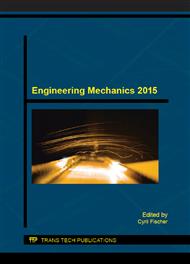p.495
p.503
p.512
p.518
p.526
p.532
p.539
p.547
p.555
Mechanical Properties of Fiber Reinforced Lime-Based Mortars Evaluated from Four-Point Bending Test
Abstract:
In the study, the bending behavior of high-performance fiber reinforced lime-based mortars is experimentally investigated using four-point bending test. From the experimental data, the influence of the mortar’s composition on its stiffness, cracking strength and ultimate strength are investigated. It is also studied, whether the response has strain-softening or strain-hardening character and whether the material exhibits multiple cracking. Such behavior is very important for the durability of the material, because it allows carrying load during imposed deformations (due to thermal effects, movements of foundations, seismicity, etc.). The number of formed cracks is examined using digital image correlation method. The mortar composition is considered with two types of binder (pure lime, lime-metakaolin), with two types of polyvinyl alcohol fibers in four volume fractions (0.5÷2.0%). As the reference, we consider two sets of specimens made of plain mortar without fiber reinforcement.
Info:
Periodical:
Pages:
526-531
Citation:
Online since:
January 2016
Authors:
Price:
Сopyright:
© 2016 Trans Tech Publications Ltd. All Rights Reserved
Share:
Citation:


